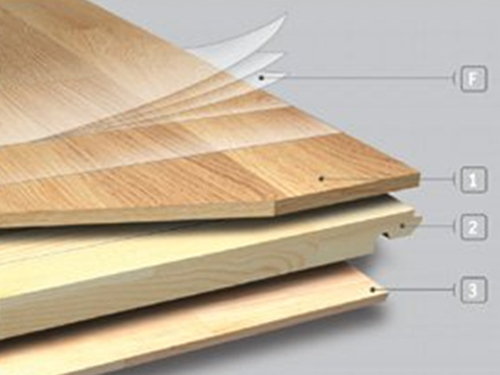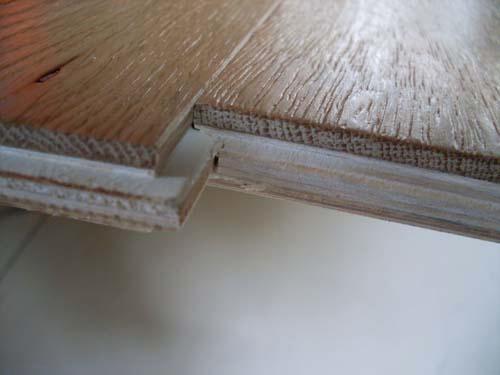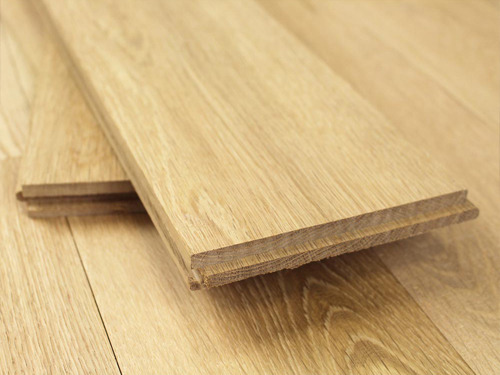Types
of Wood
Floors
Engineered Wood Floors

The diagram below shows the typical construction of a 14mm engineered wood floor.
Engineered wood flooring has a 3 layered construction. A solid wood top layer, a core layer made up of strips of wood and single piece stabilizing base layer. These types of products are normally available in various formats from 10mm through to 15mm and with top layers from 2.5mm -4mm of hardwood. The boards are tongue and grooved all round and have micro bevels on the long sides only.
Engineered wood floors can be nailed (20mm only), glued down or floated.
Engineered Wood Floors

The diagram below shows the typical construction of a 14mm engineered wood floor.
Engineered wood flooring has a 3 layered construction. A solid wood top layer, a core layer made up of strips of wood and single piece stabilizing base layer. These types of products are normally available in various formats from 10mm through to 15mm and with top layers from 2.5mm -4mm of hardwood. The boards are tongue and grooved all round and have micro bevels on the long sides only.
Engineered wood floors can be nailed (20mm only), glued down or floated.
Multifloor or Semi Solid Wooden Flooring

This range of flooring has a 2 layered construction. A 5-6mm top layer of solid wood and a base layer of 15mm plywood. The boards are tongue and grooved all round and have micro bevels on the long sides only.
Multi-floor products can be fitted as nailed down floors where the subfloor is either existing floor boards or plywood, or they can be glued down to screeds or chipboard using an appropriate parkett adhesive. We would always recommend using MS Polymer adhesive.
Multi-floor products are not suitable for a floating installation. The tongue and groove on these boards is not sufficiently well engineered to support a floating installation. If you want to float a floor you should always choose the engineered products.
Multifloor or Semi Solid Wooden Flooring

This range of flooring has a 2 layered construction. A 5-6mm top layer of solid wood and a base layer of 15mm plywood. The boards are tongue and grooved all round and have micro bevels on the long sides only.
Multi-floor products can be fitted as nailed down floors where the subfloor is either existing floor boards or plywood, or they can be glued down to screeds or chipboard using an appropriate parkett adhesive. We would always recommend using MS Polymer adhesive.
Multi-floor products are not suitable for a floating installation. The tongue and groove on these boards is not sufficiently well engineered to support a floating installation. If you want to float a floor you should always choose the engineered products.
Solid Wooden Flooring

Solid wooden flooring is a single piece of hardwood or softwood top to bottom. The boards are tongued and grooved all round and will have micro bevels on the long sides if they are supplied pre finished. Otherwise they will be square edged boards which will need to be sanded and finished on site.
The best way to fit a solid wooden flooring is by secret nailing and according to British Standards by surface fixing if the boards are over 130mm wide. Nailing should always be the preferred method of fixing but when necessary you could also glue down a solid hardwood floor. Solid floors cannot be floated as there is too much movement in a solid floor and the machining of the tongue and groove does not support this type of installation.
Solid Wooden Flooring

Solid wooden flooring is a single piece of hardwood or softwood top to bottom. The boards are tongued and grooved all round and will have micro bevels on the long sides if they are supplied pre finished. Otherwise they will be square edged boards which will need to be sanded and finished on site.
The best way to fit a solid wooden flooring is by secret nailing and according to British Standards by surface fixing if the boards are over 130mm wide. Nailing should always be the preferred method of fixing but when necessary you could also glue down a solid hardwood floor. Solid floors cannot be floated as there is too much movement in a solid floor and the machining of the tongue and groove does not support this type of installation.